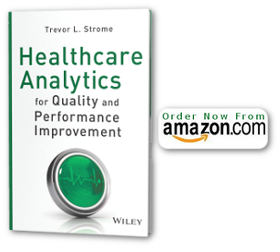There has been plenty of discussion lately about “predictive analytics”. Wikipedia defines predictive analytics as, “a variety of techniques from statistics, data mining and game theory that analyze current and historical facts to make predictions about future events.”
Business Intelligence (BI) vendors interested in acquiring (or enhancing) predictive analytics technologies hope that predictive analytics will become a key differentiator in an increasingly crowded market of very capable business intelligence tools. Some recent acquisitions (such as the purchase of statistical software maker SPSS by IBM reportedly for $1.2 billion) show that vendors are increasingly jockying for position in this highly anticipated emerging market.
How Predictive Analytics can Impact Healthcare
Predictive analytics can, potentially, have a great impact on the quality and management of healthcare organizations (HCOs). What HCO executive, program director, or department manager wouldn’t want to be able to mine existing data sources and apply predictive algorithms and tools to determine future demand for services and therefore how best to configure staffing and other resources.
The challenge is that many healthcare organizations are just now adopting the electronic tools (such as electronic medical records) to capture the rich data sets necessary to feed into predictive algorithms. In fact, many (if not most) HCOs are only now adopting BI tools and deploying advanced reporting and analysis tools strategically throughout the organization.
The good news is that healthcare has an immensely strong and talented cadre of analysts and researchers that have studied almost every conceivable issue in healthcare (from epidemics to patient flow) and have developed models using traditional statistical techniques with sometimes minimal data. Analytical software tools such as SPSS are widely used throughout healthcare organizations and research insitutions. And, there is a strong legacy in healthcare to want to understand clinical and quality issues by developing models and testing them retrospectively and prospectively.
More “Real Life” Use of Predictive Analytics
As HCOs continue to adopt information systems that collect and manage clinical and operational data and make it available to BI and analytical tools, analysts and researchers will be able to develop models that are even more detailed and accurate than before. As predictive analytics capabilities become more powerful and more accessible (i.e., via business intelligence systems such as Cognos), the “real-life” application of these models (and “next-generation” models not yet conceived of or developed) will continue to expand.
As healthcare becomes increasingly computerized, the combination of electronic charting, traditional BI, and emerging predive analytics tools should improve healthcare management, planning, and quality, and result in a healthcare system not only better understanding the healthcare needs of tomorrow, but actually being prepared for them.
Resources:

{ 0 comments… add one now }